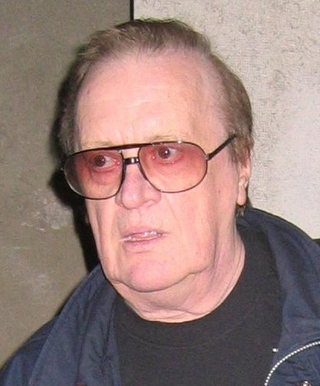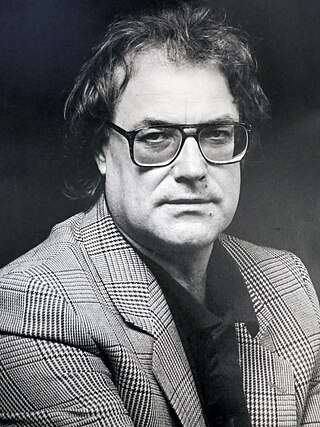Related Research Articles

The culture of Croatia has historically been influenced by Central European, Mediterranean, and Balkan cultures. Croatia's unique culture and identity can be traced back to the historical llyricum. The Croatian language is believed to have been formed in the 6th or 7th century, with the written language present in Glagolitic texts from the 11th century.

Arsenije "Arsen" Dedić was a Croatian singer-songwriter. He wrote and performed chansons, as well as film music. He was also an award-winning poet, and was one of the best-selling poets of former Yugoslavia and Croatia.

Ranko Marinković was a Croatian novelist and dramatist.

The cinema of Croatia has a somewhat shorter tradition than what is common for other Central European countries: the serious beginning of Croatian cinema starts with the rise of the Yugoslavian film industry in the 1940s. Three Croatian feature films were nominated for the Academy Award for Best Foreign Language Film, several of them gained awards at major festivals, and the Croatian contribution in the field of animation is particularly important.

Vatroslav Lisinski was a Croatian composer.

Lordan Zafranović is an eminent Croatian-Czech-Yugoslav film director known for his World War II trilogy consisting of Occupation in 26 Pictures (1978), The Fall of Italy (1981), and Evening Bells (1986), all co-written with Mirko Kovač (writer), for his experimental black and white early work, which mark him as a major figure of the Yugoslav Black Wave, and for his dauntless exploration of Ustaše crimes during the NDH period.
![<i>Ciguli Miguli</i> 1952 [[Federal Peoples Republic of Yugoslavia|Yugoslavia]] film](https://upload.wikimedia.org/wikipedia/en/0/02/Ciguli_Miguli_poster.jpg)
Ciguli Miguli is a 1952 Yugoslav political satire film directed by Branko Marjanović and written by Joža Horvat. It was meant to be the first satirical film of the post-World War II Yugoslav cinema, but its sharp criticism of bureaucracy was politically condemned by the authorities and the film was banned as "anti-socialist".

Fadil Hadžić was a Croatian and Yugoslav film director, screenwriter, playwright and journalist, mainly known for his comedy films and plays. He was born in Bileća in Bosnia and Herzegovina, but mainly lived and worked in Zagreb, with the Croatian and wider Yugoslav productions.
The Glembays is a 1988 Yugoslav film directed by Antun Vrdoljak starring Mustafa Nadarević and Ena Begović. The film is an adaptation of Miroslav Krleža's 1929 play Messrs. Glembay and was produced by Televizija Zagreb and Jadran Film.
Zvonimir Berković was a Croatian film director and screenwriter.

Black Birds is a 1967 Yugoslavian war drama film directed by Eduard Galić.

Accidental Life is a 1969 Yugoslav drama film directed by Ante Peterlić, starring Dragutin Klobučar, Ivo Serdar, Ana Karić and Zvonimir Rogoz.

The Living Truth, also released as Real Truth, is a 1972 Yugoslav film directed and written by Tomislav Radić, starring Božidarka Frajt.
The Third Key is a 1983 Croatian film directed by Zoran Tadić, starring Božidar Alić and Vedrana Međimorec. A Kafkian horror film, indirectly touching on the topic of corruption, in showing the alienation and soullessness of modern agglomerations it resembles somewhat the film Someone's Watching Me! by John Carpenter.
Eagle is a 1990 Croatian film directed by Zoran Tadić. It is based on Umjetni orao, a novel by Pavao Pavličić.

Velimir Kljaić was a Croatian handball player and coach.
Nenad Polimac is a Croatian film critic.
Milko Šparemblek is a Slovenian-born Croatian dancer, choreographer, stage director and film director. He has made about 40 ballet films and has about 150 premiers of his work in over 50 theatres around the world. He has received a number of awards including a Vladimir Nazor Lifetime Achievement Award and a Distinguished Artist Award from the International Society for the Performing Arts.
Film Authors' Studio was a short-lived but influential Croatian film production studio. Established in 1967, it was the first independent feature film production company in Yugoslavia.
Events in the year 2021 in Croatia.
References
- ↑ "Zvonimir Maycug". Baza HR kinematografije. Archived from the original on 2021-12-19. Retrieved 2022-03-06.
- 1 2 3 4 5 6 7 Luketić, Željko (2016). [Curated Retrospective] PSIHOTRONIČKI FILM (PSYCHOTRONIC FILM) Of Zvonimir Maycug - Feature Film Retrospective (in Croatian). Croatia Film Days. Archived from the original on 2021-12-19. Retrieved 2022-03-06.
- 1 2 3 4 5 6 7 8 Luketić, Željko (2011). Nakon molitve bludili smo cijeli dan: Kalvarija Zvonimira Maycuga (in Croatian). Filmonaut, 4th issue. Archived from the original on 2022-01-31. Retrieved 2022-03-06.
- ↑ "Zvonimir Maycug". Kino Tuškanac. Archived from the original on 2021-12-19. Retrieved 2022-03-06.
- 1 2 3 4 5 6 7 Polimac, Nenad (9 April 2016). "Ispovijest prvog hrvatskog pornografa: 'Snimio sam prvi pornić, a danas živim od cateringa'". Jutarnji list . Archived from the original on 19 December 2021. Retrieved 6 March 2022.
- ↑ "Kako je snimljen i zabranjen prvi YU pornić".
- ↑ Polimac, Nenad (2004). "Hrvatski trash film". Archived from the original on 9 June 2007. Retrieved 6 March 2022.
- ↑ "Casanovafest: prvi hrvatski festival ljubavi i erotike". Jutarnji list . 30 June 2009. Retrieved 4 August 2022.
- ↑ "Večeras u kinu Europa održat će se promocija novog broja hrvatskog filmskog časopisa Filmonaut". Jutarnji list . 12 December 2011. Retrieved 4 August 2022.
- ↑ Marjanović, Hrvoje (15 November 2021). "Ovih 10 domaćih filmova je takvo smeće da ćete umrijeti od smijeha (ili muke)". Index.hr . Archived from the original on 29 December 2021. Retrieved 6 March 2022.